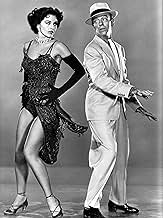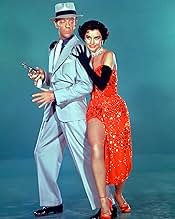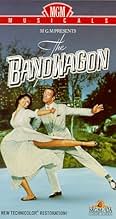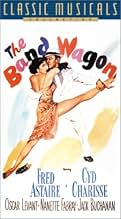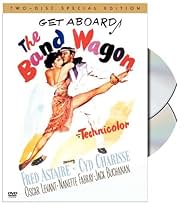अपनी भाषा में प्लॉट जोड़ेंAn aging movie star uncertain of his future teams up with a top ballerina to headline a new Broadway musical, but the pretentiously artistic goals of its director threaten to change it beyon... सभी पढ़ेंAn aging movie star uncertain of his future teams up with a top ballerina to headline a new Broadway musical, but the pretentiously artistic goals of its director threaten to change it beyond recognition.An aging movie star uncertain of his future teams up with a top ballerina to headline a new Broadway musical, but the pretentiously artistic goals of its director threaten to change it beyond recognition.
- 3 ऑस्कर के लिए नामांकित
- 2 जीत और कुल 5 नामांकन
- Gabrielle Gerard
- (गाने की आवाज)
- (बिना क्रेडिट के)
- Hot Dog Vendor
- (बिना क्रेडिट के)
- Stagehand
- (बिना क्रेडिट के)
- Train Porter
- (बिना क्रेडिट के)
- Dancer
- (बिना क्रेडिट के)
- Dancer
- (बिना क्रेडिट के)
- Dancer in Troupe
- (बिना क्रेडिट के)
- Theatre Patron
- (बिना क्रेडिट के)
- Auction Guest
- (बिना क्रेडिट के)
- Dancer in Troupe
- (बिना क्रेडिट के)
- Producer
- (बिना क्रेडिट के)
फ़ीचर्ड समीक्षाएं
It's probably hard to avoid comparing this film to SINGIN' IN THE RAIN, since they were made just a year apart and were both written by Betty Comden and Adolph Green. Moreover, the themes are even vaguely similar--THE BAND WAGON is a gentle, sharp satire on theatrical goings-on; SINGIN' IN THE RAIN a wicked parody of Hollywood and movie-making. Both films list Cyd Charisse as one of the characters; both films have a ballet section towards the end of the film. And of course, both films star (separately, unfortunately) the two greatest dancing talents of any and every Hollywood generation--Fred Astaire (TBW) and Gene Kelly (SITR). So certainly, comparisons are rife... the films seem to *beg* one to make them! Personally, the chips fall on the side of SITR for me: it's got a tighter story line, it's less talky, the chemistry between the leads is impeccable, and the songs and dances are simply wonderful.
That is, however, an entirely personal preference. There are people--there are in fact several other IMDB reviewers--who prefer THE BAND WAGON, and with good reason. Entirely on its own merits and not in comparison to SITR (as it should be judged), this film is exactly what it sets out to be: a cracking two hours worth of sheer entertainment. It's cleverly written, while the songs and dances are charming and some even mind-blowing. Vincente Minelli does an excellent job of directing; he is, after all, justly known as the master of musical films. Astaire couldn't be bad if he tried, and he's quite ably supported by his cast of Charisse, Levant, Fabray and Buchanan. The numbers range from the heartbreakingly romantic and simple (Charisse and Astaire falling in love to 'Dancing In The Dark'); through to the clever and amusing (most of the brief numbers attributed to 'The Band Wagon', the play within the movie, but most especially the 'Triplets' number with Astaire, Fabray and Buchanan); on to the rousing and hilarious (Astaire's German accent midway through 'I Love Louisa); and finally to those that are simply stunning in their sheer technical mastery (without a doubt the 'Girl Hunt' ballet). And of course, that's forgetting to mention the song that best sums up the entire spirit of THE BAND WAGON: 'That's Entertainment!'. Joyously performed by Astaire, Fabray, Buchanan and Levant (and in a finale reprisal also featuring Charisse), you really get the feeling that *this* is what Hollywood, and more specifically, the MGM musical, is about. And at the game of entertainment, THE BAND WAGON succeeds handsomely.
I think the only problem I have with THE BAND WAGON is that it just doesn't come together as perfectly and as seamlessly as I'd like. There are moments when my attention drifts, and the acting is frequently uneven. (An exception would be Fabray, who simply radiates exuberance with her big voice and great moves in relatively little screen time.) I've said that Astaire couldn't be bad if he tried. True, he *isn't* bad... just a little listless, it seems to me, particularly in the first half of the film. His dancing, however, is faultless as usual, just as you'd expect from Astaire. And he definitely seems to warm up considerably in the second half of the film. It's rather a shame that there's a spark missing from Charisse's performance as well--as a dancer she is visually *and* emotionally arresting, but she's quite frankly not as much an actress as she is a dancer. (She had the same problem in BRIGADOON, and she didn't have to act in SINGIN' IN THE RAIN except through her dancing.) Most of the time her performance is passable, reaching 'good' and occasionally 'great' at the most naturalistic parts--for example, when she's laughing or pretending to smoke with Tony. Astaire and Charisse are fantastic in their two main numbers together though--'Dancing In The Dark' is one of the best, simplest and most romantic film dances I've ever seen, and 'Girl Hunt' is so inventive and perfectly executed that you can't help thinking these two dancers really *do* match somehow.
Simply put, you just couldn't go wrong with THE BAND WAGON. You'll laugh, you'll marvel, you'll sing along... but most of all, you'll be well-entertained. And if *that's* the point the film is trying to make... point surely very well-taken! 8/10
Great dancing includes one of Fred Astaire's classic ballet duos, "Dancing in the Dark," with Cyd Charise. She does this spin ending in a semi-kneel, with the mid-calf hem of her dress landing mid-thigh, in order to display one of those spectacular gams of hers...'tis a wonder to behold! Also, there's a number with Astaire and Jack Buchanan, one of the great British variety stars. It's a delight to see this all-too-short exhibition of contrasting dance styles by two master hoofers.
And there's the added treat of Nanette Fabray and Oscar Levant (Levant being one those, like Robert Benchley, who entertains by playing himself) standing in for Comden and Green, who happened to write The Band Wagon (as well as Singin' in the Rain and Bells are Ringing). What I like about Comden and Green is, that while most all American musicals come out of New York, the sound of Comden and Green IS New York. They once said, "New York is the ongoing background of our lives - Brooklyn girl, Bronx boy - and whether we have been conscious of it or not, it is the background..."
Yes, there's the music - five numbers, part of the great repertory of American Standards: That's Entertainment, By Myself, You and the Night and the Music, Something to Remember You By, and of course Dancing in the Dark. My favorite dance number after DITD is Shine on My Shoes, surely an under-appreciated classic. All in all, a pretty good score (no pun intended), wouldn't you say?
The story is classified as a "backstage musical," and certainly it is. But there's a scene in Band Wagon with a truly documentary feel. After the show's premier, there's a dress-down cast party. The underpaid company singers and dancers really are in it for the love, and when they want to wind down, they go somewhere cozy, get their drinks and sing a lovely, subdued song, Something To Remember You By. (Of course, after Astaire joins them, the volume goes up, and it's a miracle they aren't evicted. I guess New Haven is used to it by now.) When I was a kid I was a gofer for the Metropolitan Opera when it hit my town on its spring tours, and it's why this scene in The Band Wagon rings so true: as a fly on the wall, I saw the Met company unwinding just this way.
One more element of realism (or life imitating art imitating life): according to the trivia, Buchanan had to have triple root canal work and was in pain for most of the production, and Fabray gashed her knee in "Louisiana Hayride," then had to dance on her knees for the "Triplets" number. Ouch! Talk about plucky troopers!
This was smart and sophisticated musical comedy of the 50s, an era when New York adults still set pop trends and before American culture became corrupted and dumbed down by television. It's not just nostalgia to say they don't make them like they used to.
Astaire plays has-been Hollywood star Tony Hunter who hopes to revive his popularity by returning to Broadway in a new musical written by his friends Lester and Lily Marton (Oscar Levant and Nanette Fabray in essence portraying the screenplay's authors, Adolph Green and Betty Comden).
The Martons have entrusted the staging of their show to wunderkind actor/director/producer Jeffrey Cordova (a combination caricature of Orson Welles and Jose Ferrer played by British song-and-dance man Jack Buchanan). Two of Cordova's inspirations include casting ballerina Gabrielle Gerard (Charisse) as the female lead (good idea) and turning the show into a pretentious Faust allegory (really bad idea).
Tony and Gabrielle rub each other the wrong way - at first, and Cordova's joyless concoction lays an egg. But the cast vows to forge ahead and try again with another musical, this time with no mention of hell or the devil.
As clever as the script is, the main attractions are the exquisitely performed musical numbers (written by Arthur Schwartz and Howard Dietz) including "That's Entertainment", "A Shine on Your Shoes","Dancing in the Dark" and the greatest grand finale in the history of movie musicals "The Girl Hunt Ballet", a parody of film noir with Astaire as private eye Rod Riley and Charisse in a dual role as good girl and femme fatale.
Arthur Freed had great success with two previous song catalog musicals, An American In Paris with the music of George Gershwin and Singing in the Rain which utilized the songs that he wrote with Nacio Herb Brown. His source for this film were the songs of Howard Dietz and Arthur Schwartz.
Dietz and Schwartz were an interesting pair of writers. Howard Dietz worked right at MGM in their publicity department. In fact it was Dietz who invented MGM's famous Leo the Lion. Song lyrics were in fact an avocation. Arthur Schwartz was a lawyer who just one day gave up the practice of law to devote himself to songwriting. They wrote some of the best music of the Thirties. After which Dietz devoted himself to publicizing MGM and Schwartz worked with other lyricists.
They wrote revues and this is where the source material for The Band Wagon comes from. In fact one of their revues was entitled The Band Wagon and starred none other than Fred and Adele Astaire. However the team got together again and wrote one new number for the film, the legendary That's Entertainment.
This The Band Wagon is not a revue. The plot concerns an aging musical film star Fred Astaire, talked into coming east by husband and wife writing team Nanette Fabray and Oscar Levant. They want him to do a Broadway show to revive his career. They get Broadway wunderkind Jack Buchanan to direct it and later on classical ballet star Cyd Charisse to team with Astaire.
Buchanan is outrageously funny as he first tries to get them to do an avant garde musical about the Faust saga. When that flops, he's a good enough trooper to put ego aside and do some serious rewriting. And this man certainly has one Texas size ego. According to a book on the Arthur Freed musicals, Buchanan was in a lot of pain from arthritis and doing some of those numbers, especially Triplets was agony for him.
That was not the only problem on the set. It was a pretty grim place. Oscar Levant had suffered a heart attack before the production and he was ten times his normal hypochondriac self. And Fred Astaire's wife was terminally ill at home.
Cyd Charisse gauging the mood of her fellow cast members just kept to herself, but Nanette Fabray who is an exuberant personality did not go over well as Miss Perky. She recorded it was one of her worst film experiences.
Still this monumental triumph of a film got made. My favorite of all the numbers besides That's Entertainment is the soft shoe duet that Fred Astaire and Jack Buchanan partner in. It's all grace and elegance and so typically Fred Astaire. And it's probably what most people know of Jack Buchanan. Over in the United Kingdom he was a leading stage and screen performer. Until The Band Wagon was made he was probably best known to American audiences as Jeanette MacDonald's leading man in Monte Carlo.
Cyd Charisse dances divinely as she always does, never better than in the finale, The Girl Hunt Ballet with Astaire. I still wonder why she never starred at MGM with her husband Tony Martin.
When one is asked what the American musical film ideal is, one of the best answers you can give is The Band Wagon.
क्या आपको पता है
- ट्रिवियाIn the DVD bonus features, Nanette Fabray stated that Oscar Levant was difficult to work with. Whenever something would go wrong or he would make a mistake, he would blame whoever was around. This included stage hands, other actors, lighting technicians, or whoever was handy. She said that, since she was usually closest, she caught the brunt of it. Following a botched take, he again blamed her for something. She lost her temper and told him off using unladylike language. Everyone on the set applauded. After that, he was much easier to work with.
- गूफ़At the New York opening night, the theater name on the marquee is Alcott Theatre, but the program cover has Stratton Theatre.
- भाव
Gabrielle Gerard: Oh, that's a very early Degas, isn't it?
[examines painting]
Gabrielle Gerard: 1877.
Tony Hunter: [playing up their age difference] Yeah, I swiped it from his desk in school. Was he sore.
- इसके अलावा अन्य वर्जनThere is an Italian edition of this film on DVD, distributed by DNA srl, "THE BAND WAGON (Spettacolo di varietà, 1953) - New Widescreen Edition + IL SIGNORE IN MARSINA (1943)" (2 Films on a single DVD, with "The Band Wagon" in double version 1.33:1 and 1.78:1), re-edited with the contribution of film historian Riccardo Cusin. This version is also available for streaming on some platforms.
- कनेक्शनEdited into Hollywood: The Dream Factory (1972)
- साउंडट्रैकBy Myself
(1937) (uncredited)
Music by Arthur Schwartz
Lyrics by Howard Dietz
Performed by Fred Astaire twice
टॉप पसंद
विवरण
- रिलीज़ की तारीख़
- कंट्री ऑफ़ ओरिजिन
- भाषाएं
- इस रूप में भी जाना जाता है
- Brindis al amor
- फ़िल्माने की जगहें
- 214 West 42nd Street, मैनहटन, न्यूयॉर्क शहर, न्यूयॉर्क, संयुक्त राज्य अमेरिका(establishing shot showing the New Amsterdam Theatre)
- उत्पादन कंपनी
- IMDbPro पर और कंपनी क्रेडिट देखें
बॉक्स ऑफ़िस
- बजट
- $21,69,120(अनुमानित)
- दुनिया भर में सकल
- $15,009
- चलने की अवधि1 घंटा 52 मिनट
- पक्ष अनुपात
- 1.33 : 1
इस पेज में योगदान दें





